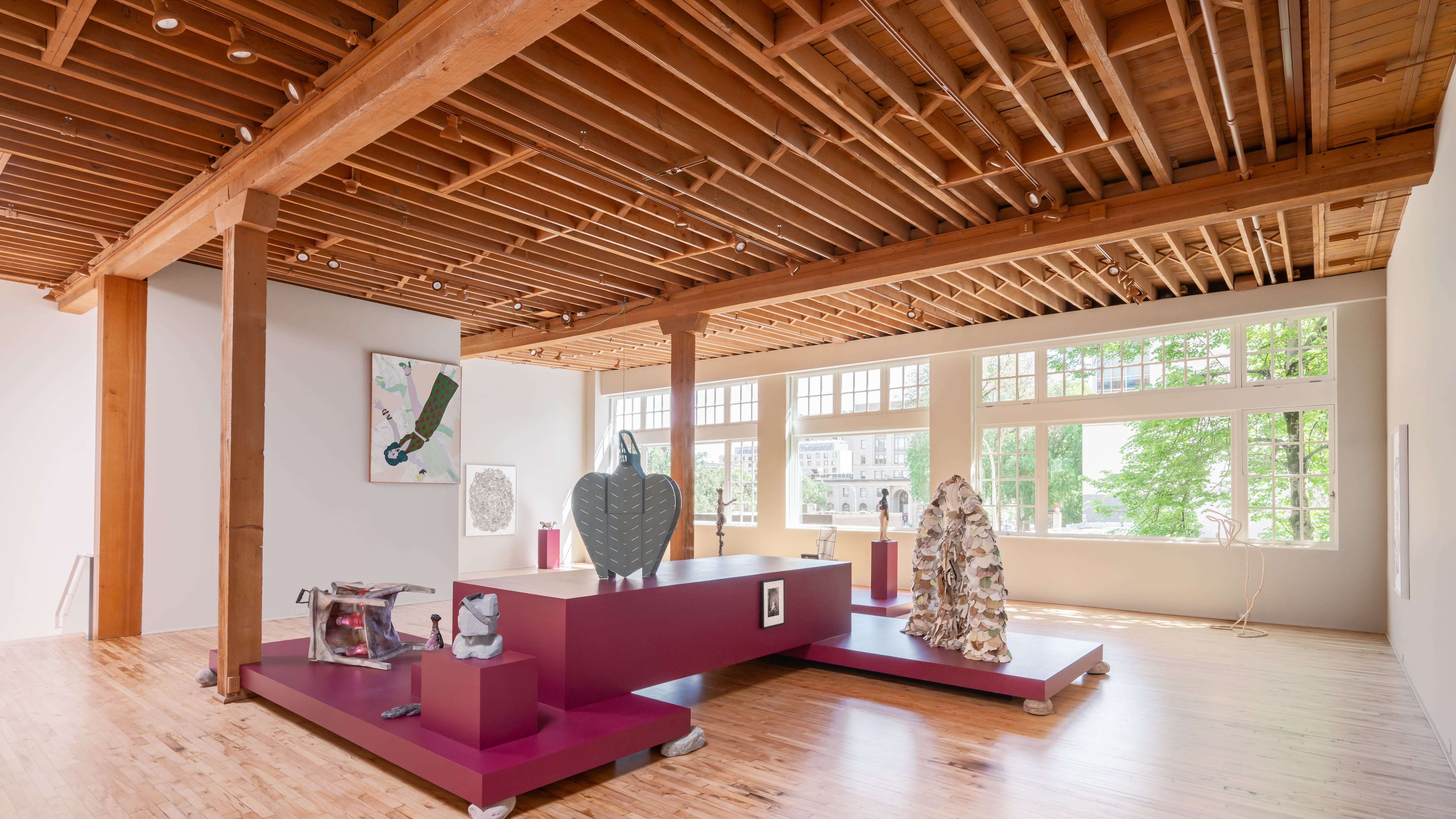Chorus, the current exhibition on view through July 19 in the lumber room, an art venue in the Pearl District, asks visitors to consider its title’s many meanings through the lens of works from the Miller Meigs Collection—an art collection built by lumber room owner Sarah Miller Meigs to support socially underrepresented artists. The exhibition’s sculptures, prints and videos call out together across decades of art history (from 1957 to 2024, to be exact) collectively singing or commenting, through their unique arrangements, on the current moment’s joys and tragedies, underscoring a refrain in unanimity and returning to themes of mutual interest.
An aura of intrigue surrounds this exhibition. Its design—by lumber room director Libby Werbel and Spencer Byrne-Seres of the artist support service Visitor Projects—functions as a major symbolic framing for a constellation of artworks that manifest as sentinels throughout the space. Several large oval stones help hold up the base of tiered mauve platforms elevating many of these artworks, reflecting the theatricality and mundanity of daily life. Many of the tipping, spiraling and dangling pieces seem to reach toward possibilities.
Rapunzel, Senga Nengudi’s gelatin silver print situated on the first floor near the venue’s entrance, depicts a pair of pantyhose extending out of a window frame toward two bits of rebar protruding from the tattered building façade below, a conduit between worlds. On the stairway wall leading to the main room hangs two inconspicuous but elongated, overlapping tongues from Jenine Marsh’s mounted sculpture The Articulate Muscle. The tongues, made of varnished white clay, twist and curve with one reaching down into the central fold of the other, providing a sensual welcome to the primary space.
Precarity presents itself as a theme, a disturbance of balance that causes all kinds of fallout. Dom Perignon 1, a large painting by Kiki Kogelnik, greets visitors near the entrance to the second level of the lumber room, the exhibition’s main floor. Kogelnik depicts a shocked femme suspended mid-fall with a glass of bubbly in her hand. Obscured behind her, a shadowy version of this femme appears upright, grounded in an alternate universe. This work seems to reflect the duality of social masking, and the interior panic and cognitive dissonance this generates. Across from this, Kaari Upson’s sculpture Untitled (Grandpa Table), is tipped on its side and crumpled slightly. Untitled (Grandpa Table) holds several irons and lustrous pink bottles that protrude from its side-lying surfaces. The table appears as if it had been overturned and overwhelmed by emotional as well as physical forces.
An untitled gelatin silver print by Ana Mendieta—the tragic post-World War II heroine of feminist art—hangs discreetly below Green Bodice, a robust sculpture by Diane Simpson. Mendieta’s print depicts a body crouched in a taut white sheet and posed in a Greco-Roman-looking alcove, while Green Bodice appears like a small sage green throne on bulbous legs. These two shapes—the sheet-covered body and the “bodice”—abstract idealized femininity, redacting facial pleasantries with rounded and guttural resonance. They assert steadfastness and refusal through their manners of taking up space.
Rose B. Simpson’s sculpture Jet Pack 1 dialogues with many other works from its perch. This humanoid figure has no arms, a black upper body and sandy-hued legs. It stands stalwartly with several rings strapped to its back, poised as if awaiting ascendance. Nearby, Lee Relvas’ wooden sculpture Feeling, presumably formed in the hollow outline of another humanoid, bends ardently downward with arms and palms folding near its empty chest. This being emotes many possible sensations—grief, gratitude, heartbreak, relief. Both of these sculptures gesture to the gravity of the earth and its precious materiality that enables movement.
In the lumber room’s small movie theater space plays Hiraki Sawa’s animated video Migration, wherein a number of miniature naked humans and animals of all kinds walk across the surfaces of a real-life kitchen, each on their own journeys. They do not seem headed anywhere in particular but are driven to keep moving on these intuitive pathways. Sawa’s Migration acts as a visualization for this exhibition—artists on their respective trajectories that create spontaneous, compelling compositions with one another.
From the richness of the mauve “stages” that many of the artworks perform upon, to the cavernous feel of the lumber room itself, Chorus offers up space for exploring harmony and dissonance of collectivity. This exhibition also reminds that collectivity is not to be mistaken for sameness or conformity. Rather, it indicates the presence of invisible threads that connect and hold humans accountable to one another, to the earth, and to shared pasts and futures.
CORRECTION: Due to an editor’s error, a previous version of this story incorrectly spelled Sarah Miller Meigs’ name. WW regrets the error.
SEE IT: Chorus at the lumber room, 419 NW 9th Ave., lumberroom.com. Noon–5 pm Friday–Saturday.

